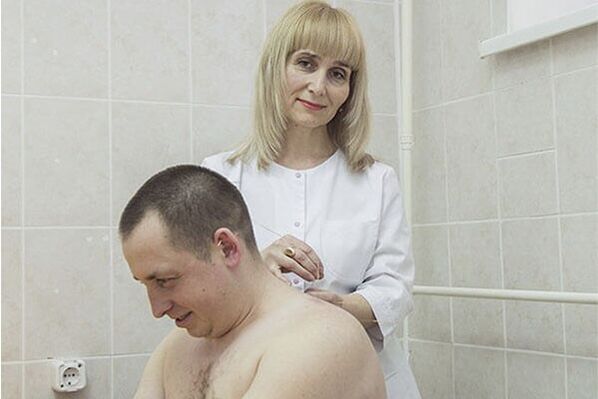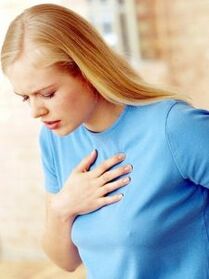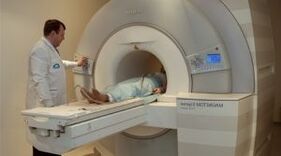Thoracic spinal osteochondrosis is a disease of the musculoskeletal system, the success of treatment that depends on the timing of the diagnosis.It is true -it is actually healed in the early stages, but it is difficult to determine the source of the disease, as the patient initially does not suspect that the pain and discomfort arising are associated with damage to the spine: they do not interfere with him, and he does not rush to the doctor.

Let's try to deal with the symptoms of osteochondrosis, the nature of its occurrence, the possibility of treatment and prevention of the disease.
Thoracic spine osteochondrosis
- The disease is characterized by dystrophic and degenerative changes in the thoracic spine, which is associated with cell metabolism.
- In the intervertebral disc, protrusion (thinning and cracking) occurs - the cause of the spinal cord compression, the limbs numbness, paralysis.This is the stage of the disease when only surgery will help.
- The job of the patient and the doctor to take steps on timely diagnosis and proper treatment.
Symptoms of disease
The first symptom of osteochondrosis of the spinal cord area:
- back pain (dorsalgia);
- acute pain in the chest area (dorsago);
- Discomfort during movement, I do not want to move again so as not to feel pain.
All of these are symptoms of highlights - thinning, intervertebral disc cracks.Pain appears in the area of the kidneys, liver, heart, pancreas, stomach.The pathology of the thoracic region is indicated by intercostal neuralgia, horizontal arthrosis, and ribs and pectory arthrosis.A deep complaint or cough causes pain or compression or presence of heavy coma in the chest.

Usually spinal osteochondrosis is characterized by syndrome:
- Characteristics of vasomotor syndrome neurological diseases.Patients feel redness suddenly, similar to climate, organ pain, other systems.
- Muscle-tonic syndrome in muscle tissue near the focus of the disease.With increased physical activity, the area is swollen.
- Neurodistrophic syndrome (Zuzhek disease) or metabolism in tissue can also be a symptom of disease.
The difference of other illnesses
Difficulty in diagnosis and early detection of osteochondrosis of the chest are symptoms that are easily confused with others.
For example, pectalgy is not only a sign of breast osteochondrosis, but also myocardial infarction.
With damage to the spine, the symptoms of intelligence occur with the turn of the head, the trunk and lasting, for more than two weeks.Nitroglycerin in this case is useless.For comparison: with coronary disease, the same pain persists in a short period of time.The "Cardon" drug will help get rid of or help relieve it.
Pain in the areas of attachment, kidneys, stomach, intestines - symptoms of somatic disease: appendicitis, nephritis, pyelonephritis, gastritis, stomach ulcer, colitis.During compression (pinching) spinal cord, symptoms of the characteristics of the disease are indicated.Pseudo syndrome -usiose or redness, severity in the chest varies from angina, characteristics of patients with angina pectoris.Such pain can be caused by chest pathology, cervix-thoracic, cervical parts, causing painful tissue processes: muscles and nerves.Pain with pseudo syndrome -usiose syndrome occurs with the upper body turn.
Symptoms of compression syndrome are signs of extramedullar neoplasmic nerves.
Due to the similarity of osteochondrosis of the spinal cord with other diseases, the main thing is accurate diagnosis, which is a complex step.
Development
Let's think about what happens when osteochondrosis occurs:
- First of all, the disc is modified: it is sophisticated, covered with cracks, defects.At this stage, the disease does not appear symptoms, and the patient does not feel anything.
- Then there is pain related to the nerve ending irritation that is in the tissue next to the affected disc.In people with advanced muscle mass, the risk of pathological processes is much smaller, as the muscles support the spine, such as the corset.Pain can be neurological, such as numbness from the limbs, appearance of goosebumps, modification of the internal organs of the chest.
In the first two stages, the disease is cured.
- Next, the process of inflammation, hernia, arthrosis, individual vertebral subluxation can develop.The most common is the hernia where the pulpoose spine is always supported by fibrous rings.When the ring is destroyed, the core crawls, causing acute pain, numbness, paralysis.
- In the fourth stage, narrowing of the disc occurs, abnormal bone tissue growth is possible.So the spine protects itself from the harmful compression of the spinal cord.
In severe cases, the spinal cord syndrome due to highlights can cause the pain attached, decreased sensitivity (gipalgesia).
A factor in the development of disease
The thoracic spinal osteochondrosis develops due to inadequate supply of intervertebral discs with useful materials and moisture.The spinal disc is different from other body tissues as they are not supplied with elements of nutrients through the network of vessels and feeds from neighboring tissues.With fluid deficiency, nutrients, a phenomenon called protrusion is characterized by lukan, refinement, cracks and destruction of intervertebral discs.
Degenerative changes arise for the following reasons:
- Descendants, which are associated with backwardness and pathology of blood circulation.
- Congenital, causing the emergence of weakness of the musculoskeletal system: rickets, kyphosis, scoliosis, prayer.
- The salt deposit next to the disc (osteophytes), publishes problems at the time of investigating the spine.
- Violation of nutritional metabolism, micro -circulation in tissues as a result of injuries and infectious diseases
People at risk:
- experienced heavy physical activity;
- with improper posture, where from time to time there is the same pathology as after injury;
- have inactive work;
- Works with professions related to continuous long shaking organisms (drivers).
When to see a doctor?
With spinal disease to your doctor, you need to go quickly.How to understand that the case is in the spine?With osteochondrosis, it is difficult to understand or not immediately.In the first stage, pain is not felt.
Remember!If there is pain in the chest and back, the right source is difficult to determine, as it is "fluttering" through the body: first it hurts adjacent, then alternating -shoulders, ribs, collarbone, in any massage.This is the most common sign of damage to the thoracic spine.
Is it possible to reduce the pain before meeting a doctor?
So far no accurate diagnosis, radical treatment methods have not been used.In fact, there are diseases where, for example, thermal procedures are prohibited (with several types of tumors).With sharp pain, drunken painkillers and ambulance calls.In other cases, heavy loads are excluded by sedatives, finding simple body positions, and avoiding sharp shock (jumping) effects.At the first opportunity, they went to the doctor to confirm the diagnosis and prescribe treatment.
Diagnosis of spinal osteochondrosis in the chest area

Always conduct a comprehensive examination aimed at eliminating the disease with the same symptoms.
Diagnostic methods include:
- Anamnesis;
- Inspection and palpation;
- Computer tomography, which determines the right diagnosis and explains the stage of disease progression;
- Radiography as an alternative tomography method, able to expose cracks to discs and formed growth;
- Ultrasound, ECG, gastroscopy, fluorography, general tests that do not include disease, similar to symptoms similar to osteochondrosis.
A more complete diagnosis, more accurate diagnosis.Along with osteochondrosis, other spinal pathology can be detected, taking into account the doctor when diagnosing and prescribing treatment.
How to treat spinal osteochondrosis?
Medical treatment of osteochondrosis will lead to complete healing of the patient if the diagnosis is timely.
- First and foremost, it is addressed to relieve pain, for this purpose, medications are prescribed - analgesics, source of pain with novocaine injection, for some time releasing patients from unbearable pain;
- Physium with current, laser, magnetopunctural device;
- Needleoflexotherapy or acupuncture, run by a professional doctor;
- Therapeutic gymnastics under the supervision of physiotherapists;
- the purpose of chondroprotectors;
- Surgical intervention is changed in severe cases, when other methods are not useful.
The recovery of the people
All people's methods of treating osteochondrosis are divided into pathogenetic and symptoms.Pathogenetic - aimed at combating the disease.These include:
- physiotherapy procedures;
- Massage begins with 8-12 minutes of pain point study, then time increases;Massage is only indicated without acute pain;
- Diet, in which patients reject wine and legumes, systematically accept substances containing natural chondroitin, materials that help strengthen the intervertebral disc: jellied meat, soup and.and more, the use of vegetables and fruits that contribute to the cleansing of the body;
- During the appearance of acute pain - warming with salt, sand;
- acupuncture.
Symptoms agents aimed at relieving the symptoms of the disease including external and internal phytotherapy.
Prevention
To prevent osteochondrosis, in general, and osteochondrosis of the spinal thoracic area, in particular, some conditions must be met:
- Sleep on hard surfaces and pillows with slopes no more than 15 degrees, compared to mattresses;
- Avoid too high loads on the spine and profession, which is associated with a shaking body;
- Look at the right lifestyle;
- regularly drinking water, preventing dehydration;
- Pregnant women are registered early, using vitamins and elements that contribute to proper fetal development;
- Prevention of rickets in children, which is a prevention of disruption in the musculoskeletal system.
Spinal osteochondrosis is a treatable disease, especially in the first stage.In the future, if it is not possible to completely overcome the disease, there is no reason to give up.Existing methods of treatment are designed to significantly reduce the suffering of the patient.Initial diagnosis, the implementation of all prescriptions of the doctor can completely save the patient from a tiring disease.























